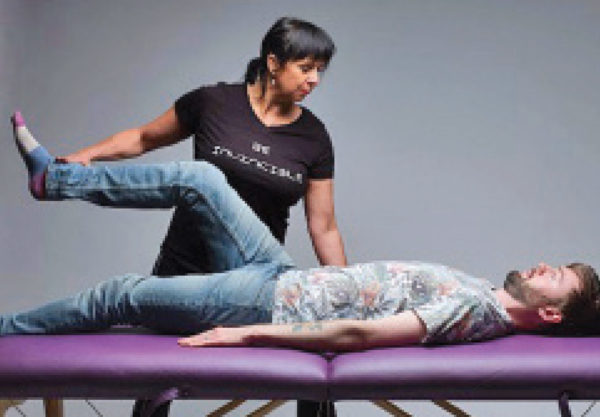
By Eoin Meegan
Muscular and joint pain is, unfortunately, something all too many people are familiar with, and can range from being mildly irritable to downright debilitating. However, there may be relief on the horizon in the form of a relatively new treatment known as neuromuscular therapy, or neuroconnective therapy.
Recently NewsFour met neuromuscular therapist Bev Porrino, who works out of the Elbowroom in Brunswick Street. Bev describes the science of neuromuscular therapy as a “method that helps the body to align itself with the nervous system.”
During a typical session Bev usually starts off testing the muscles for strength, flexibility and resilience. The reason for this, she says, is to know what the body is doing now and learn where to go from here.
Muscle testing, also referred to as kinesiology, determines if one part of the body is compensating for another; that is doing work it shouldn’t be doing. For example, back muscles sometimes compensate for impaired hip or glutes to propel us forward, which will inevitably lead to back pain and poor posture.
Having found the source, the therapist can then activate certain myofascial points in the body (facia are fibrous bands clustered around muscles, ligaments and tendons) through kneading, and thereby relieve the pain and bring the body back into alignment.
“When there is pain it is often the body telling us that something is not right,” Bev says, “this may result from an injury or accident, but it can also have an emotional or psychological basis.” The pain is usually a result; the cause sometimes can have its origin in a trauma or event that happened in childhood, or perhaps in an ongoing situation in our current home or work environment.
Neuromuscular therapy is a mind-body discipline that acknowledges the integrity of the musculoskeletal and the neurological systems, and recognises that you can’t do something to one without impacting on the other. In this way it is intrinsically holistic.
Bev’s work draws on that of Douglas Heel, a pioneer in this field, and creator of the Be Activated program. Heel has worked with a number of celebrities, including the South African Springboks. Be Activated segregates the body into three separate zones for purposes of analyses. Zone 1 is confined to the pelvic area, zone 2 the area down to the knees and up to the solar plexus, and zone 3 covers everything below the knee and the upper body. “Neuroconnective therapy,” Bev says, “interrupts poor neuromuscular patterns and delivers a systematic method to reawaken muscles that have become confused and switched off.”
Bev’s passion is to help people understand how amazing their bodies are, and how quickly they can change emotional states and override muscle tension and stress in the mind and body.
A Mancunian by birth, she lived for many years in Amsterdam, before relocating to Dublin in 2012, where she’s been living since. Drawing from many healing and therapeutic modalities, including elements of Be Activated and Bio Hatha yoga, which she’s been teaching for 25 years, Bev is a highly experienced and intuitive healer.
“The nervous system is like any other electrical circuit, it will find the quickest route to where the demand is called for, and sometimes this demand is coming from the wrong place. It’s like when a fuse blows the electric circuitry in your home and someone rewires it, but they do it wrong,” she says, “or like a computer that’s running slow.”
When I went for a session recently with Bev the first thing she did after muscle testing was to reset my vagus nerve. The vagus nerve is a complicated system of nerves that connects the brain to the heart, the gut, the immune system, and many other organs. It is the longest, largest, and most complex of the cranial nerves; called vagus from the Latin for ‘wandering.’
“Without resetting the vagus nerve, nothing will change,” Bev says. Having worked on my myofascial points, Bev then taught me a new diaphragmatic form of breathing, which gave me a sense of expanding, like my inside was somehow more spacious. My lower back pain has also greatly improved.
Douglas Heel said: “The body has two priorities for survival, the need to breathe and the need to move, and it will sacrifice anything else to achieve these two things.”
While neuromuscular therapy has been growing in popularity recently, it has, in fact, been around for some time. It was developed in the early part of the last century by Dr Stanley Lief and others. Janet Travell, a pioneer of trigger point therapy is credited with having helped John F. Kennedy, who famously suffered with chronic back pain.
So, if you have difficulty walking, getting around, or you’re in physical pain which is preventing you getting a proper night’s sleep, then perhaps it’s worth giving neuromuscular therapy some consideration. Many experts attest that the treatment can also help with disorders such as sciatica, carpal tunnel, and in some cases even Parkinson’s.
You can contact Bev through her website www.bevporrino.com/ or go along to one of her yoga classes (when everything reopens), which operate on a drop-in basis every Thursday lunchtime at the Elbowroom.



